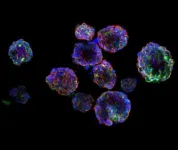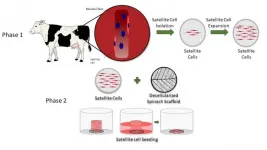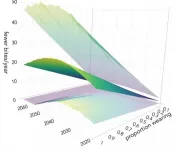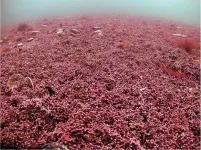Creation of 3D organoid models to fine-tune radiation dose for nasopharyngeal cancer
First of its kind 3D organoid models of nasopharyngeal cancer help to fine-tune radiation doses, and lower the chances of Nasopharyngeal Cancer recurrence and reduce mortality rate.
2021-03-31
(Press-News.org) A*STAR's Institute of Bioengineering and Nanotechnology (IBN) has teamed up with Singapore Institute of Advanced Medicine Holdings Pte Ltd (SIAMH) to establish the first of its kind in-vitro patient-derived 3D organoid models of Nasopharyngeal Cancer (NPC).
The study was published in Frontiers in Oncology on 23 February 2021. It is the first direct experimental evidence to predict optimal Radiation Treatment (RT) boost dose required to cause sufficient damage to recurrent hypoxic (low oxygen level) NPC tumour cells, which can be further used to develop dose-painting algorithms in clinical practice.
Two patient-derived xenograft (PDX) lines were used to further establish in-vitro 3D models of hypoxic radioresistant NPC for the first time. This collaboration helps to fine-tune radiation treatment, lower the chances of recurrence of NPC and reduce the mortality rate.
Nasopharyngeal carcinoma is endemic in east and southeast Asia, where 95% of the cases are invariably associated with Epstein-Barr virus (EBV) infection. More than 50% of the patients present with locally advanced and distant metastasis during initial diagnosis, and the 5-year survival rate reduces to between 50% to 70%. The disease is most prevalent in Brunei, Maldives, Indonesia, and Singapore.
The current treatment for NPC includes Radiation Treatment. There are recurrent cases that occur due to insufficient radiation. This poses a clinical challenge to the oncologists. Usually, radiotherapy is used as a re-treatment on inoperable advanced recurrent cases. This results in patients having complications during treatment and the 5-year survival rate will be reduced further. With no relevant in-vitro models to study NPC except the C666-1 cell-line which was established in late 1990's, the lack of disease-specific in-vitro models of NPC has further hindered the development of personalised therapeutic options.
IBN and SIAMH collaborated with the Singapore General Hospital and The Hong Kong University of Science and Technology to create the new in-vitro hypoxic 3D organoid models. These mimicked the hypoxic radioresistant sub-volumes of recurrent NPC, and were found to closely resemble NPC patient tumours.
By using novel patient-derived 3D models, IBN and SIAMH were able to determine experimentally on the radiobiological parameters which provide a better guide in radiation dosing, such that hypoxic radioresistant NPC cells could be eliminated, thus reducing the chances of tumour recurrences.
The study has demonstrated that radiation dose escalation by about 1.4 folds to the hypoxic radioresistant areas in the tumour would further improve the outcome of the treatment. Delivering high dose radiation - in a smaller number of fractions (hypofractionated radiotherapy) may be the way to treat hypoxic radioresistant NPCs. This could reduce long-term side effects, mortality rates due to recurrence, and improve patients' quality of life.
Dr Lucky Sasidharan, Postdoctoral Fellow at A*STAR's IBN and first author of the Frontiers in Oncology paper said, "These insights may help to develop personalised radiotherapy regimens and dose painting algorithms which could save time and lives through the prevention of re-irradiation or re-treatment."
Dr Djeng Shih Kien, Chairman and CEO of SIAMH said, "We are indeed very happy to work with IBN and contribute towards the findings of escalating dose and fractionation of radiotherapy in the treatment of hypoxic radioresistant Nasopharyngeal carcinoma.
The use of in-vitro 3D organoid models of patient-derived xenografts for the first time opens up unlimited opportunities for further research with proton beams when it is available towards the end of 2021.
SIAMH's Proton Therapy Centre is a member of the FlashForwardTM Consortium and it will be extremely exciting to study the effects of Flash Therapy on hypoxic radioresistant 3D models of NPC."
IBN is planning to work with experts at the Proton Therapy Centre located in Biopolis on this study for evaluating the effects and benefit of utilising Proton therapy and Ultra-High Dose Rate (FLASH) Radiotherapy for the treatment of NPC. These new platforms would also add the advantage of delivering very high radiation doses in sub-seconds with high precision targeting on just the areas of the tumours -and sparing the surrounding normal tissues. IBN and SIAMH have been collaborating since 2019 to explore how to better tackle NPC.
INFORMATION:
About the Institute of Bioengineering and Nanotechnology (IBN)
The Institute of Bioengineering and Nanotechnology (IBN) is the world's first bioengineering and nanotechnology research institute. Established in 2003, IBN's mission is to conduct multidisciplinary research across science, engineering and medicine for breakthroughs to improve healthcare and quality of life. IBN's research activities are focused on Biomedical Devices & Diagnostics and Bioengineering Systems. The Institute has published over 1,200 papers in leading scientific journals, filed over 685 patents and patent applications on its inventions and established 12 spin-off companies. To nurture young research talents, IBN offers students research attachment opportunities and exposure to biomedical research.
For more information on IBN, please visit http://www.a-star.edu.sg/ibn.
About the Agency for Science, Technology and Research (A*STAR)
The Agency for Science, Technology and Research (A*STAR) is Singapore's lead public sector agency that spearheads economic oriented research to advance scientific discovery and develop innovative technology. Through open innovation, we collaborate with our partners in both the public and private sectors to benefit society
As a Science and Technology Organisation, A*STAR bridges the gap between academia and industry. Our research creates economic growth and jobs for Singapore, and enhances lives by contributing to societal benefits such as improving outcomes in healthcare, urban living, and sustainability.
We play a key role in nurturing and developing a diversity of talent and leaders in our Agency and research entities, the wider research community and industry. A*STAR's R&D activities span biomedical sciences and physical sciences and engineering, with research entities primarily located in Biopolis and Fusionopolis.
For ongoing news, visit http://www.a-star.edu.sg.
About Singapore Institute of Advanced Medicine Holdings Pte Ltd
Proton Therapy Pte Ltd, a subsidiary of the Singapore Institute of Advanced Medicine Holdings Pte Ltd (SIAMH), will provide proton beam therapy treatment in Singapore. It is part of a new oncology center that is located at Biopolis, Singapore. The new comprehensive oncology center includes a diagnostic center providing both imaging and laboratory services using advance medical technologies, nuclear medicine, theranostics, radiotherapy and also health screening. Its training facility, the Advanced Medicine Training Centre, will provide the necessary training to the specialists in this part of the world. For more information, search proton.sg.
[Attachments] See images for this press release:

ELSE PRESS RELEASES FROM THIS DATE:
2021-03-31
Researchers from Loyola Marymount University, San Diego State University, Indian Institute of Management, and Iowa State University published a new paper in the Journal of Marketing that examines how effective marketplace participation by subsistence consumers requires knowledge and skills that relate to what, how, and why to participate.
The study, forthcoming in the Journal of Marketing, is titled "Marketplace Literacy as a Pathway to a Better World: Evidence from Field Experiments in Low-Access Subsistence Marketplaces" and is authored by Madhu Viswanathan, Nita Umashankar, Arun Sreekumar, and Ashley Goreczny.
Success for marketers looking to emerging markets for growth is inextricably ...
2021-03-31
COLUMBUS, Ohio - Bangladesh's floating gardens, built to grow food during flood seasons, could offer a sustainable solution for parts of the world prone to flooding because of climate change, a new study has found.
The study, published recently in the Journal of Agriculture, Food and Environment, suggests that floating gardens might not only help reduce food insecurity, but could also provide income for rural households in flood-prone parts of Bangladesh.
"We are focused here on adaptive change for people who are victims of climate change, but who did not cause climate ...
2021-03-31
PULLMAN, Wash. -- Nature's strongest material now has some stiff competition. For the first time, researchers have hard evidence that human-made hexagonal diamonds are stiffer than the common cubic diamonds found in nature and often used in jewelry.
Named for their six-sided crystal structure, hexagonal diamonds have been found at some meteorite impact sites, and others have been made briefly in labs, but these were either too small or had too short of an existence to be measured.
Now scientists at Washington State University's Institute for Shock Physics created hexagonal diamonds large enough to measure ...
2021-03-31
Chestnut Hill, Mass. (3/31/21) -- Spinach, a cost-efficient and environmentally friendly scaffold, provided an edible platform upon which a team of researchers led by a Boston College engineer has grown meat cells, an advance that may accelerate the development of cultured meat, according to a new report in the advance online edition of the journal Food BioScience.
Stripped of all but its veiny skeleton, the circulatory network of a spinach leaf successfully served as an edible substrate upon which the researchers grew bovine animal protein, said Boston College Professor of Engineering Glenn Gaudette, the lead author of the new study. The results may help increase the production of cellular agriculture ...
2021-03-31
Research published today in the peer-reviewed Journal of Vertebrate Paleontology describes a newly discovered species of dinosaur - named the 'one who causes fear', or Llukalkan aliocranianus.
Around 80 million years ago as tyrannosaurs ruled the Northern Hemisphere, this lookalike was one of 10 currently known species of abelisaurids flourishing in the southern continents.
A fearsome killer, Llukalkan was "likely among the top predators" throughout Patagonia, now in Argentina, during the Late Cretaceous due to its formidable size (up to five meters long), extremely powerful ...
2021-03-31
Early treatment with anti-VEGF injections slowed diabetic retinopathy in a clinical study from the DRCR Retina Network (DRCR.net). However, two years into the four-year study its effect on vision was similar to standard treatment, which usually begins at the onset of late disease. The intermediate findings published today in the JAMA Ophthalmology. The study was supported by the National Eye Institute (NEI), a part of the National Institutes of Health.
"While it is possible that preventive injections of anti-VEGF drugs may help protect vision in the longer-term, ...
2021-03-31
A new mathematical model suggests that the easing of lockdown must be accompanied by wider and more effective use of control measures such as facemasks even with vaccination, in order to suppress COVID-19 more quickly and reduce the likelihood of another lockdown.
The model, developed by scientists at the Universities of Cambridge and Liverpool, is published today in the Journal of the Royal Society Interface. It uses mathematical equations to provide general insights about how COVID-19 will spread under different potential control scenarios.
Control measures involving facemasks, handwashing and short-scale (1-2 metre) social distancing can all limit the number of virus particles being spread between people. These are termed ...
2021-03-31
With shark bites increasing in countries like Australia - scientists say the use of personal electronic deterrents is an effective way to prevent future deaths and injuries which could save the lives of up to 1063 Australians along the coastline over the next 50 years.
The research, published in scientific journal Royal Society Open Science, shows that while shark bites are rare events, strategies to reduce shark-bite risk are also valuable because they can severely affect victims and their support groups - with one third of victims experiencing post-traumatic stress ...
2021-03-31
Heart attacks in young adults are twice as likely to be fatal in those with inflammatory conditions like psoriasis, lupus or rheumatoid arthritis. That's the finding of a study published today in the European Journal of Preventive Cardiology, a journal of the European Society of Cardiology (ESC).1
At least 2% of people in Europe and worldwide have systemic inflammatory diseases, which often affect multiple organ systems. Many of these systemic inflammatory diseases are driven by autoimmunity, meaning the body's immune system attacks itself. Psoriasis is the most common and causes red, itchy, scaly patches on the skin, and can also cause inflammation in the joints. Rheumatoid arthritis leads to inflammation in joints of the hands and feet and in other organ systems. In systemic ...
2021-03-31
Red algae that grow in Cornwall's Fal Estuary are genetically unique, new research shows.
University of Exeter scientists studied the population genetics of Phymatolithon calcareum, a coralline red algal species that forms maerl beds in shallow coastal seas from Portugal to Norway.
Large maerl beds fulfil a similar role to tropical coral reefs, providing habitats and vital shelter for hundreds or even thousands of fish and invertebrates. These algae also play an important role in storing carbon.
The findings reveal genetic differences are "structured geographically", with slight variations between populations sampled from across this large geographic area.
However, maerl ...
LAST 30 PRESS RELEASES:
[Press-News.org] Creation of 3D organoid models to fine-tune radiation dose for nasopharyngeal cancer
First of its kind 3D organoid models of nasopharyngeal cancer help to fine-tune radiation doses, and lower the chances of Nasopharyngeal Cancer recurrence and reduce mortality rate.




